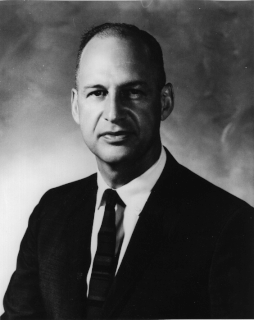Related Research Articles

Rensselaer Polytechnic Institute (RPI) is a private research university in Troy, New York, with additional campuses in Hartford and Groton, Connecticut. It was established in 1824 by Stephen van Rensselaer and Amos Eaton for the "application of science to the common purposes of life" and is the oldest technological university in the English-speaking world. Numerous American colleges or departments of applied sciences were modeled after Rensselaer.

George Michael Low was a NASA administrator and 14th President of Rensselaer Polytechnic Institute. Low was one of the senior NASA officials who made numerous critical decisions in the Apollo program of crewed missions to the Moon.

Robert Channing Seamans Jr. was an MIT professor who served as NASA Deputy Administrator and 9th United States Secretary of the Air Force.
Nikhil Koratkar is the John A. Clark and Edward T. Crossan Endowed Chair Professor of Mechanical Engineering and Materials Science at Rensselaer Polytechnic Institute who has pursued research into one-dimensional and two-dimensional materials and devices. In 2010, he was appointed Editor of the Elsevier journal CARBON.
Palmer Chamberlain Ricketts was the ninth president of Rensselaer Polytechnic Institute. He served as president for 33 years and oversaw a period of major expansion and development of the university.
Robert Byron Pipes is an educator, researcher in polymer sciences and was the seventeenth president of Rensselaer Polytechnic Institute.
Daniel Berg is a scientist, educator and was the fifteenth president of Rensselaer Polytechnic Institute.
Satya Atluri is a world-renowned Indian-American engineer, educator, researcher and scientist in aerospace engineering, mechanical engineering and computational sciences, who is currently the Presidential Chair & University Distinguished Professor at Texas Tech University. Since 1966, he made fundamental contributions to the development of finite element methods, boundary element methods, Meshless Local Petrov-Galerkin (MLPG) methods, Fragile Points Methods (FPM), Local Variational Iteration Methods, for general problems of engineering, solid mechanics, fluid dynamics, heat transfer, flexoelectricity, ferromagnetics, gradient and nonlocal theories, nonlinear dynamics, shell theories, micromechanics of materials, structural integrity and damage tolerance, Orbital mechanics, Astrodynamics, etc.
Robert H. Scanlan (1914-2001) was an American civil and aeronautical engineer who came to be widely recognized as a leader in the analysis of wind effects on large structures. Scanlan created the concept of flutter derivatives to aid in the representation of self-excited forces in theoretical models. His research in the area of bridge aerodynamics made possible the construction of larger, sturdier, and more cost-effective bridges. Scanlan worked in both industry and academia, and his employers included Republic Aviation, the Federal Aviation Administration, the French agencies CNRS and ONERA, Schlumberger, the Case Institute of Technology, Princeton University, and Johns Hopkins University. In the course of his life, Scanlan published two textbooks, "Aircraft Vibration and Flutter" and "Wind Effects on Large Structures," which are used by engineers worldwide.

Matthew Albert Hunter (1878-1961) was a metallurgist and inventor of the Hunter process for producing titanium metal.
The history of Rensselaer Polytechnic Institute (RPI) spans nearly two hundred years beginning with its founding in 1824. RPI is the oldest continuously operating technological university in both the English-speaking world and the Americas. The Institute was the first to grant a civil engineering degree in the United States, in 1835. More recently, RPI also offered the first environmental engineering degree in the United States in 1961, and possibly the first ever undergraduate degree in video game design, in 2007.
Jacob Fish is a researcher and professor in computational mechanics. He was the Rosalind and John J. Redfern Jr. Chaired Professor of Mechanical and Aeronautical Engineering at Rensselaer Polytechnic Institute and director of RPI's Multiscale Science and Engineering Center. He is currently the Robert A. W. and Christine S. Carleton Professor in Civil Engineering at Columbia University.
Robert Henry Widmer was an American aeronautical engineer who specialized in designing aircraft for the military. He spent his career working for Convair which became General Dynamics, then Lockheed, and then Lockheed Martin. His feisty personality and at times insubordinate attitude at one time led company leaders to strongly consider firing him. However, his brilliance at envisioning and designing desirable aircraft years before there was even a market for them led to his appointment as Vice President for science and engineering for all of General Dynamics.
Nancy Burr Deloye Fitzroy is an American engineer specializing in heat transfer and fluid dynamics.
Montgomery Knight was an aeronautical engineer who specialized in rotary-wing aircraft. He was the first director of the Guggenheim School of Aeronautics at the Georgia Institute of Technology and a founder of and long-time researcher at the Georgia Tech Research Institute.
Alexander Alexandrovitch Nikolsky was a Russian-born American aeronautical engineer who worked in the domain of rotary-wing aircraft.

Prof. Alfred Gessow was an American pioneer in the field of helicopter aerodynamics and aerospace engineering. He was a co-author of the early rotorcraft engineering text, Aerodynamics of the Helicopter, which, although published in 1952, has been in print for more than 50 years. Prof. Gessow was Chair of the Department of Aerospace Engineering at the University of Maryland, College Park, and was ultimately promoted to Professor Emeritus.

Lois Graham was a professor of thermodynamics and cryogenics. She was the first woman to earn a mechanical engineering PhD in the United States.
Achille Messac is the Dean of the College of Engineering, Architecture and Computer Sciences at Howard University. He has previously served as Professor of Aerospace Engineering Mississippi State University. He was elected a Fellow of the American Association for the Advancement of Science in 2019.
References
- ↑ Who's who in American Jewry. Standard Who's Who. 1980. ISSN 0196-8009 . Retrieved 2014-10-11.
- 1 2 "Robert G. Loewy". RPI Archives. Retrieved 2009-08-07.
- ↑ "Robert Loewy Awarded Guggenheim Medal". Georgia Tech. 2006-07-06. Archived from the original on 2012-04-03. Retrieved 2009-08-06.
- ↑ "Robert G. Loewy". RPI Alumni Hall of Fame. Retrieved 2009-08-06.